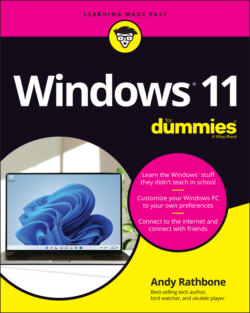Читать книгу Windows 11 For Dummies - Andy Rathbone - Страница 22
Being Welcomed to the World of Windows
ОглавлениеStarting Windows is as easy as turning on your computer — Windows leaps onto the screen automatically with a flourish. But before you can begin working, Windows stops you cold: It displays what’s called a lock screen, shown in Figure 2-1, with no entrance key dangling nearby.
FIGURE 2-1: To move past this lock screen, press a key on the keyboard or drag up on the screen with your mouse or finger.
Introduced back in Windows 8, the lock screen appears before you can sign in to your computer with your account name.
How do you unlock the lock screen? The answer depends on whether you’re using a mouse, keyboard, or touchscreen:
Mouse: On a desktop PC or laptop, click any mouse button.
Keyboard: Press any key, and the lock screen slides away. Easy!
Touch: Touch the screen with your finger and then slide your finger up the glass. A quick flick of the finger will do.
When you’re in the door, Windows wants you to sign in, as shown in Figure 2-2, by clicking your name and passing the security check.
FIGURE 2-2: Click your user account name and then type your password or PIN on the next screen.
When facing the Sign In screen, you have several options:
If you see your name or email address listed, type your password or PIN, or use a Windows Hello fingerprint reader or camera. After verifying your identity, Windows lets you in and displays your Start menu, just as you last left it. (I describe how to set up Windows Hello in Chapter 14.)
If you don’t see your name, but you have an account on the computer, look in the screen’s lower-left corner. There, Windows displays a list of all the account holders. You may see the computer owner’s name.
If you bought a new computer, use the account you created when turning on your computer for the first time. As part of its setup process, Windows guides you through creating a Microsoft account on your computer.
No account? Then find out who owns the computer and beg that person to set up an account for you.
If you need more information about user accounts, including creating new ones, managing old ones, flip ahead to Chapter 14.
Don’t want to sign in at the Sign In screen? Two of the screen’s bottom-corner buttons offer these other options:
The little figurine, shown in Figure 2-2 and the margin, customizes Windows for people with physical challenges in hearing, sight, or manual dexterity, all covered in Chapter 12. If you choose this button by mistake, click or touch on a different part of the screen to avoid changing any settings.
The little round button, shown in Figure 2-2 and the margin, lets you shut down or restart your PC, as well as put it to sleep — a power-saving state that quickly awakes. (If you’ve accidentally clicked the button and shut down your PC, don’t panic. Press the power button on your PC’s case, and your PC returns to this screen.)
Even while locked, as shown earlier in Figure 2-1, your computer’s screen displays current information in its lower-right corner. Depending on how your PC is configured, you may see the time and date; your wireless internet signal strength (the more radio waves in the icon, the better your connection); battery strength (the more colorful the icon, the better); your next scheduled appointment; a count of unread email; and other items.
